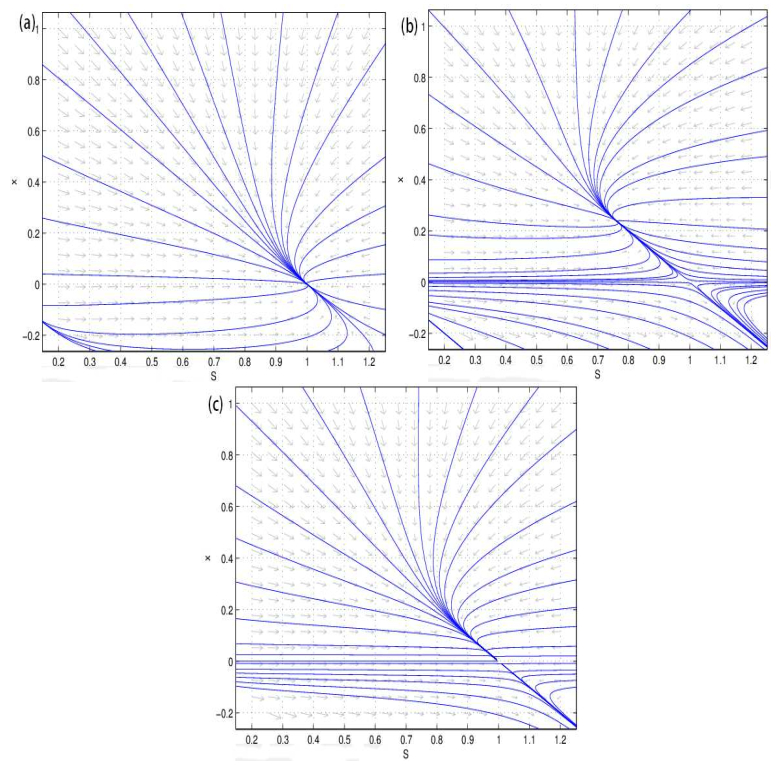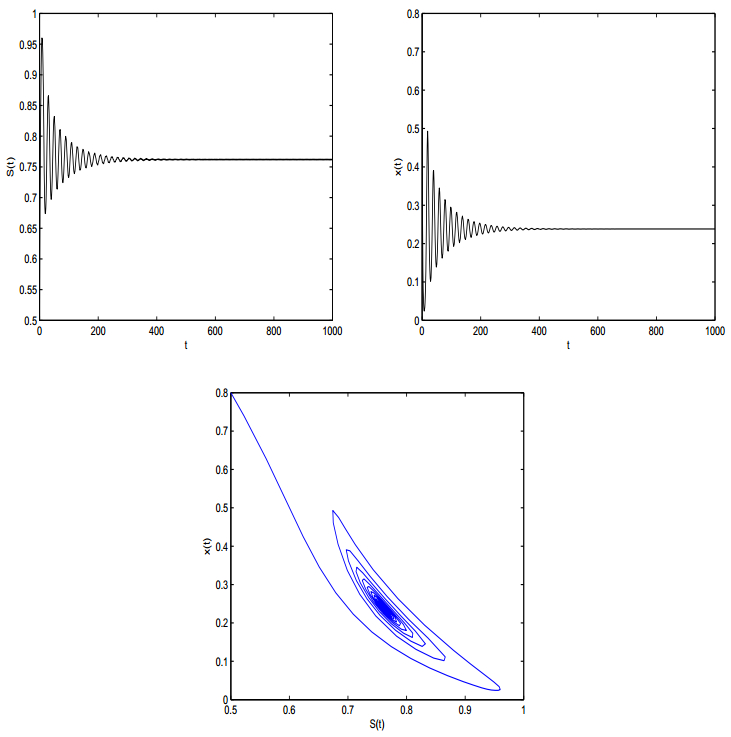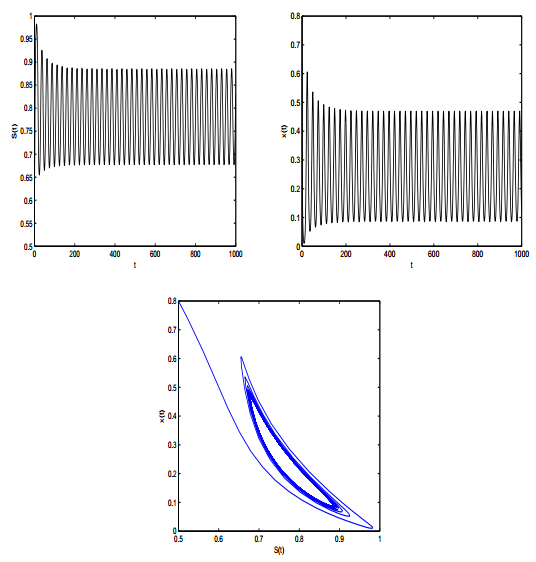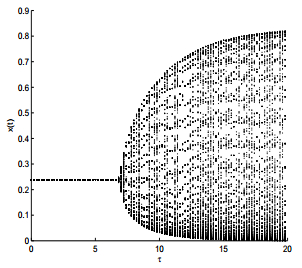In this contribution, the dynamic behaviors of a turbidostat model with Contois growth rate and delay are investigated. The qualitative properties of the system are carried out including the stability of the equilibria and the bifurcations. More concretely, we exhibit the transcritical bifurcation by reducing the system without delay to a 1-dimensional system on a center manifold and find that Hopf bifurcation occurs by choosing the delay as bifurcation parameter. Also, using the normal form theory and the center manifold theorem we determine the direction and stability of the bifurcating periodic solutions induced by the Hopf bifurcation. Finally, numerical simulations are presented to support our theoretical results.
1.
Introduction
The chemostat is a laboratory bio-reactor used for the continuous culture of microorganism (Figure 1). The apparatus is of both ecological and mathematical interest since it can be used to represent a lot of microorganism systems, such as the simple lake and the waste-water treatment, and plays an important role in micrology and population [8,9,30].
Recently, a large of research devoted to modifying the chemostat for higher economical values by controlling the dilution rate of the chemostat. The chemostat with the feedback control of the dilution rate is established, which is referred to as turbidostat by biologists [14] (Figure 1). In the turbidostat, the optical sensor measures the concentration of the microorganism and the signal feedback control the dilution rate. For example, Flegr [5] analyzed the coexistence of two species in the turbidostat by numerical analysis, and later Leenheer and Smith [13] also demonstrated results of Flegr by theoretical analysis. They showed that a turbidostat with monotone response functions permits a unique coexistence equilibrium and if it is locally asymptotically stable then it is globally attracting. Furthermore, they also obtained that coexistence is not achievable in the turbidostat with more than two competing organisms. Li [14] established a mathematical model of competition in a turbidostat for an inhibitory nutrient and achieved the stability of the equilibrium and the existence of limit cycles. Li and Chen [16] studied a mathematical model of the turbidostat with impulsive state feedback control and obtained the existence and the stability of periodic solutions of order one.
The uptake function in the model of microorganism continuous culture is the growth rate of the microorganism including many forms, such as, Monod [19], Moser [20] and Contois [4]. The most classical and common uptake function is Monod one, which is the function of concentration of microorganism and the constant half saturation term. However, Contois [4] presented experimental results to show that it is not necessarily a constant. Thus, the uptake function of Contois was introduced, which depends on the ratio substrate to microorganism. Jost [24] explored the relation of the Contois growth rate in microbiology and the ratio-dependent functional response in population ecology introduced by Arditi and Ginzburg [1]. As such, many researchers also call it ratio-dependent growth rate just as in population ecology [10,11,17,34]. Especially, Hu et al. [11] investigated the existence and the stability of the periodic solution of order one for the turbidostat system with ratio-dependent growth rate and impulsive state feedback control. The Contois model gave predictions that were in excellent agreement with experiment measurement. Especially, the Contois model was found to accurately describe the processing of industrial wastewaters. Nelson investigated a series of chemostat models with Contois growth rate. For example, Nelson and Sidhu [21] investigated the Hopf bifurcation and degenerate Hopf bifurcation of the chemostat model with Contois growth rate and the variable yield. Alqahtani et al. [22] studied the chemostat model with variable yield and contois growth kinetics with substrate inhibition and showed the Hopf bifurcation, degenerate Hopf bifurcation and Bogdanov-Takens bifurcation.
Researchers recognized that time delays are natural in the ecological systems [12,27,29]. Smith and Waltman [30] showed that there are two obvious sources of delays in the cultivation of microorganism, one of which is the possibility that the microorganism stores the nutrient. Caperon [3] first introduced the delay into the chemostat model by some experiments. Bush and Cook [2] corrected Caperon's model and established a chemostat model with delay in the growth rate of microorganism. The time delays yield some complex impacts to the chemostat model and biologists gave the reasonable explanations for the observations and experimental datas by investigating the chemostat model with delays [18,15,23,26,31]. For example, Li et al. [15] considered the global dynamics of the chemostat model with two populations of microorganisms competing for two perfectly complementary nutrients when distributed delays are involved. Ruan and Wolkowicz [26] studied the existence and the stability of the Hopf bifurcation of the chemostat model with a distributed delay and found that the periodic solutions become unstable if the dilution rate is increased. Wang and Wolkowicz [31] analyzed the local stability of the equilibria and the globally asymptotical stability of the single species survival equilibrium when n species compete in the chemostat with time delay for a single resource, hence the competitive exclusion principle holds. Yao et al. [32] discussed the delayed turbidostat model with Monod growth rate and obtained the phenomenon of oscillation. In the turbidostat, additional factor causing delay is due to the process that the sensor controls the dilution, for example, Tagashira and Hara [28] and Yuan et al. [33] considered the turbidostat models of the dilution rate with delayed feedback control.
Li and Xu [17] investigated the following chemostat system with Contois growth rate and time delay
where S(t) and x(t) present the concentration of substrate and the concentration of microorganism at time t , respectively, S0>0 stands for the input concentration of the nutrient, α+βS(t) (α>0,β>0) is variable yield,
m>0 and a>0 are growth parameters of the microorganism,
τ>0 is the time delay of the growth response of the microorganism, and d>0 presents the flow volume. They considered the local and global stability of the equilibria and Hopf bifurcation.
In this paper, motivated by the works of Bush and Cook ([2]), Contois ([4]) and Li and Xu ([17]), one focuses on the dynamics of a turbidostat model with Contois growth rate and time delay which follows as
where S(t) , x(t) and parameters S0 , m , a , τ are defined as in (1.1), γ>0 is yield constant and d+kx(t) (d>0,k>0) presents the dilution rate of the turbidostat.
The aim of this paper is to investigate the qualitative properties of system (1.2) including the stability of the equilibria and the bifurcations. The outline of this paper is as follows. In Section 2, I analyze the existence and local stability of the equilibria, and the transcritical bifurcation at the boundary equilibrium and the Hopf bifurcation at the positive equilibrium. In Section 3 mostly focuses on the stability and type of the bifurcating periodic solutions induced by Hopf bifurcation to system (1.2). I in Section 4 further illustrate our main results by numerical simulations.
2.
Stability of the equilibria and bifurcations
In this section, we investigate the existence and stability of the equilibria and the bifurcations at equilibria including the transcritical bifurcation and Hopf bifurcation of system (1.2).
It is convenient to introduce dimensionless variables. In particular, we set
System (1.2) becomes
where we still denote ˜S,˜x,˜k,˜a,˜m,˜t with S,x,k,a,m,t , respectively. First of all, we discuss the existence of the equilibria of system (2.1) and have the following result.
Lemma 2.1. System (2.1) always has a boundary equilibrium E0:(1,0) ; If m>1 , then system (2.1) has a unique positive equilibrium E1:(S∗,x∗) , where S∗=1+km+k when a=1 ,
when a≠1 and x∗=1−S∗ .
Proof. From the right part of system (2.1), we can obtain the boundary equilibrium easily, which we denote as E0:(1,0) . In order to get the positive equilibrium, we need to discuss the roots of the equation mSa+(1−a)S−1−k(1−S)=0 on the interval (0,1) . We define
Therefore, we just need to discuss the zeros of the function f(S) on the interval (0,1) , which need to be discussed in the following three cases.
(ⅰ). If a=1 , then we have f(S)=(k+m)S−1−K and f(S) has a zero S=1+km+k on the interval (0,1) when m>1 , and f(S) has no zero on the interval (0,1) when m≤1 . Thus, we obtain S∗=1+km+k when a=1 and m>1 .
(ⅱ). If 0<a<1 , then f(S) is a quadratic function of S . Since the coefficient of quadratic term k(1−a)>0 and f(0)=−a(1+k)<0 , f(S)=0 has two roots
and it is obvious that S1<0,S2>0 . By simplifying the inequality S2<1 , we can get that S2<1 if and only if m>1 . Thus, we have S∗=S2 when 0<a<1 and m>1 .
(ⅲ). If a>1 , then f(S) still is a quadratic function of S with the coefficient of quadratic term k(1−a)<0 and f(0)=−a(1+k)<0 . The discriminant of f(S) is
We can take Δ as the function of a . Therefore, the discriminant of Δ is ˜Δ:=km(m−1)(1+k) . For this case we need further discussion in the following three cases.
(a). If m=1 , then ˜Δ=0 and the double root of Δ=0 is −k . Therefore, Δ>0 holds when a>1 . We have f(S)=0 has two roots S1=a(1+k)k(a−1)>1 and S2=1 . Thus, f(S) has no zero on the interval (0,1) when a>1 and m=1 .
(b). If m<1 , then ˜Δ<0 , which implies Δ>0 . We have f(S) has two roots S1 and S2 presented in (2.3) and S2<S1 . By simplifying S2>1 , we can get that S2>1 if and only if m<1 . Thus, f(S) has no zero on the interval (0,1) when a>1 and m<1 .
(c). If m>1 , then ˜Δ>0 . Since 4km−2k+2m−2>0 and (k−m+1)2≥0 , the two roots of Δ=0 denoted by a1 and a2 satisfy a1<a2≤0 . Therefore, Δ>0 holds when a>1 and m>1 . We obtain f(S) has two roots presented in (2.3) and S1>S2 . Further, we can get 0<S2<1 if and only if m>1 and a>1 . Suppose that S1<1 , then we get m>1 , which is a contradiction. Thus, we have S∗=S2 when a>1 and m>1 .
This completes the proof.
From the above analysis we have the existence of equilibria of system (2.1). In the following, we consider qualitative properties of system (2.1) including stability of the equilibria and the bifurcations. We discuss system (2.1) in two cases: (ⅰ) τ=0 and (ⅱ) τ>0 .
Case (ⅰ): τ=0 , i.e. there is no time delay in system (2.1), then system (2.1) becomes
We first investigate the stability of the equilibria E0 and E1 and have the following result.
Theorem 2.2. If m<1 , then E0 is a stable node; If m>1 , then E0 is a saddle and E1 is a stable node; If m=1 , then E0 is a saddle-node.
Proof. The Jacobian matrix at E0 is
The determinant, trace and discriminant are respectively
If m<1 , then D0>0 and T0<0 . Thus, E0 is a stable node. If m>1 , then D0<0 . Thus, E0 is a saddle. If m=1 , then D0=0 and T0=−1 . This is the degenerate case, which needs further discussion.
Translating the equilibrium E0 to the origin by ˜S=S−1 , system (2.4) becomes the following system
where we still use S to present ˜S . Using the linear transformation u=x , v=S+x and time-rescaling t1=−t to normalize the linear part of system (2.5), we can change system (2.5) into the following
where we still denote t1 as t . By the implicit function theorem, there is a unique function v=ϕ(u) such that Ψ(u,v)=0 . We can obtain v=ϕ(u)=0 by solving Ψ(u,v)=0 . Substituting v=0 into Φ(u,v)=0 , we get
Thus E0 is a saddle-node when m=1 by Theorem 7.1 in Zhang et al. ([35]). Moreover, the parabolic sector of the saddle-node lies on the right-hand plane in the (u,v) -coordinates and the two hyperbolic sectors lie on the left-hand plane since a+k>0 .
We continue to prove the properties of E1 .
The Jacobian matrix at E1 is
The determinant, trace and discriminant of J1 are respectively
Thus, E1 is a stable node if it exists.
We complete the proof.
It is indicated in Lemma 2.1 that system (2.4) has either exact one equilibrium E0 when m≤1 or exact two equilibria E0 and E1 when m>1 . In the following we reduce the system to a 1-dimensional system on a center manifold and display the mechanism for E1 to arise.
Theorem 2.3. System (2.4) experiences a transcritical bifurcation at E0 when m=1 .
Proof. Let ε=m−1 and translate the equilibrium E0 to the origin by ˜S=S−1 , system (2.4) becomes the following system
where we still denote ˜S as S .
Applying the transformation S=−u+v and x=u to diagonalize the linear part of system (2.7), we can change system (2.7) into the suspended system
By the center manifold theory, system (2.8}) has a two-dimensional center manifold Wc:v=h(u,ε) near O , which is tangent to the plane v=0 at O in the (u,v,ε) -space. In order to obtain the second-order approximation of function h , we set
Substituting (2.9) into the equality ˙v=hu˙u and comparing the coefficient of u2 , ε2 and uε , we have a1=b1=c1=0 . Hence the center manifold is v=o(|u,ε|2) and the restricted system of (2.8}) on the center manifold (2.9) is
The expression (2.10) shows that a transcritical bifurcation occurs at E0 as ε varies through the bifurcation value ε=0 ([6]). More concretely, when ε<0 , E0 is stable and the other equilibrium appears on the negative u -axis; when ε=0 , the two equilibria coincide at E0 , which is a saddle-node; when ε>0 , E0 remains an equilibrium but is unstable while a stable equilibrium E1 arises.
We complete the proof.
Case (ⅱ): τ>0 .
In this case we will investigate the effect of time delay on the system. The time delay can cause the loss of stability of E1 and can induce periodic solutions. Note that if m>1 , then system (2.1) has a unique positive equilibrium E1 . To further consider the local stability of E1 and the Hopf bifurcations induced by the delay, we set ˜x(t)=x(t)−x∗,˜S(t)=S(t)−S∗ and still denote ˜x,˜S as x,S . Then system (2.1) can be changed into the following system
where
The following characteristic equation can be achieved from the linear system of system (2.11)
To investigate the stability of the equilibrium E1 and Hopf bifurcation of (2.1), we must study the distribution of the roots of (2.12).
Lemma 2.4. If a11b12+a12b11−a11b13<0 , then ±iw0(w0>0) are the eigenvalues of (2.12) when τ=τj . The values of w0
and τj can be presented as follows
Proof. If λ=iw (w>0) is a root of (2.12), then we have
Separating the real and imaginary parts, we obtain
which implies the following equation
Denote
Since
and the condition a11b12+a12b11−a11b13<0 , we have the constant term of h(w) is negative. In addition, we can obtain the coefficient of quadratic term of h(w) is positive. In fact,
Thus, h(w) has a unique positive real root
Substituting w0 into (2.13), we conclude that
Hence, (2.12) has a pair of purely imaginary roots ±iw0 as τ=τj, j=0,1,2⋯ .
This completes the proof.
Let λ(τ)=α(τ)+iβ(τ) denote the root of (2.12) near τ=τj satisfying α(τj)=0 and β(τj)=w0 . Then we have the following transversality condition.
Lemma 2.5. The following transversality condition holds
Proof. Differentiating (2.12) with respect to τ yields that
Thus,
Since h(w) is a quartic function of w and the leading coefficient of which is positive, furthermore, from the analysis of Lemma 2.4, we obtain that the four roots of equation h(w)=0 are a pair of conjugate complex roots, a negative real root and a positive real root w0 , respectively. Hence h(w) is monotonically increasing at w0 , i.e., h′(w0)>0 , which implies h′(w0)/{2w30b213+2w0(a11b13−a12b11)2}>0 . Thus, we have
The proof is completed.
Now we have the following result about the distribution of the roots of the exponential polynomial (2.12) by Corollary 2.4 in [25].
Lemma 2.6. Suppose that w0 and τj (j=0,1,2⋯) are defined by (2.14) and (2.15), respectively. We have the following results
(i ) If a11b12+a12b11−a11b13≥0 , then all the roots of (2.12) have negative real parts for all τ>0 .
(ii ) If a11b12+a12b11−a11b13<0 and τ=τj , then (2.12) has a pair of simple imaginary roots ±iw0 . Furthermore, if τ∈[0,τ0) , then all the roots of (2.12) have negative real parts; if
τ∈(τj,τj+1),j=0,1,2⋯ , then (2.12) has at least one root with positive real parts.
From Lemma 2.4, Lemma 2.5, Lemma 2.6 and the Hopf bifurcation theorem, we have the following result of E1 .
Theorem 2.7. For system (2.1), we have
(i ) if a11b12+a12b11−a11b13≥0 , then the unique positive equilibrium
E1 is asymptotically stable for all τ≥0 .
(ii ) if a11b12+a12b11−a11b13<0 , then the equilibrium E1
is asymptotically stable for τ∈[0,τ0) and unstable for
τ>τ0 . Hopf bifurcation occurs when τ=τj,j=0,1,2⋯ .
3.
Direction and stability of the hopf bifurcation
In this section, we consider the direction and stability of the bifurcating periodic solutions of system (2.1) induced by the Hopf bifurcation by using the normal form theory and the center manifold theorem by Hassard et al. ([7]). We compute (see Appendix for details of the computation)
where the first four coefficients g20 , g11 , g02 and g21 that we need for determining the properties of the Hopf bifurcation are of the following forms
in which the terms W(1)11(0) , W(2)11(0) , W(1)11(−1) , W(2)11(−1) , W(1)20(0) , W(2)20(0) , W(1)20(−1) , W(2)20(−1) , q1 , q∗1 and ˉD are calculated in Appendix.
Now using the four coefficients we obtain the values of the parameters μ2 , β2 and T2
Thus, using the quantities above, the properties of the Hopf bifurcation are determined by the following theorem.
Theorem 3.1. The properties of the Hopf bifurcation are determined by the parameters μ2 , β2 and T2 , where
μ2 determines the direction of the Hopf bifurcation: if
μ2>0 (<0) , then the Hopf bifurcation is supercritical (subcritical); β2 determines the stability of the bifurcating periodic solutions: if β2<0 (>0) , the bifurcating periodic solutions are stable (unstable); and T2 determines the period of the bifurcating periodic solutions: if T2>0 (<0) , the period increases (decreases).
4.
Numerical simulation and discussion
We discussed a turbidostat system with Contois growth rate and time delay in this paper. We investigated the qualitative properties of system (1.2) including the existence and the stability of the equilibria and the bifurcations. In the case of no time delay, the boundary equilibrium E0 is globally asymptotically stable if it is the unique equilibrium, and the positive equilibrium E1 arising from a transcritical bifurcation is globally asymptotically stable if it exists. In the case of system with delay, the stability of E1 is changed and the Hopf bifurcation occurs by choosing the delay as the bifurcation parameter. Furthermore, the stability and direction of the bifurcating periodic solutions are discussed by using the normal form and center manifold theorem. More concretely, when the delay is greater than the critical value τ0 , the positive equilibrium E1 loses its stability and the stable periodic solution appears. The qualitative analysis and theoretical results show that the delay can change the topological structures of the system and produces more complicated dynamic behaviors.
We next offer an example to illustrate the feasibility of our results. When system (2.1) without delay, i.e. τ=0 , we set a=1 and k=0.6 , the system has the unique equilibrium E0 , which is a stable node as m=0.5 ; the system has a saddle E0 and a stable node E1=(0.76,0.24) as m=1.5 ; the system has the unique equilibrium E0 , which is a saddle-node as m=1 (Figure 2). However, when m=1.5 , a=1 and k=0.6 , by choosing the time delay τ as the bifurcation parameter, we obtained the critical value of bifurcation τ0≈7 . Thus, the positive equilibrium E1 is asymptotically stable when τ=6<τ0 , which is supported by Figure 3. The positive equilibrium E1 is unstable and a stable bifurcating periodic solution occurs from E1 when τ=8>τ0 , which can be seen clearly in Figure 4. According to (4.10) we can compute
Further, we can get
Then, in accordance with (4.22), we can obtain
Therefore, when τ=8 , μ2>0 and β2<0 , then the Hopf bifurcation for system (2.1) is supercritical and the stable bifurcating periodic solutions occur from the positive equilibrium E1 . From Figure 3 and Figure 4, we can find that the dynamics of system (2.1) change when τ locates near τ0 . The bifurcation diagram of x−τ is presented in Figure 5, from which we find that even for parameter values not chosen, the stable periodic solutions occur in a large region of time delay.
Remark 1. This is a remark about Figure 2. In fact, considering the biological background, the set Ω={(S,x):0≤S≤1,x≥0} is positively invariant with respect to system (2.4). Further, E0 is globally asymptotically stable with respect to Ω if m<1 ; E0 is globally attractive with respect to Ω if m=1 ; and E1 is globally asymptotically stable with respect to Ω if m>1 . These results can be proved easily by Liapunov-LaSalle invariant principle and Poincare-Bendixson Theorem respectively.
Acknowledgments
The author is very grateful to the anonymous referees for their careful reading and valuable suggestions, which have notably improved the quality of this paper.
Conflict of interest
All authors declare no conflicts of interest in this paper.
Appendix
We obtained in Section 2 that system (2.1) undergoes the Hopf bifurcation at the positive equilibrium E1 when τ=τj . In the following the properties of the Hopf bifurcation are determined. We first consider system (2.1) by the transformation ˜y1(t)=S(τt), ˜y2(t)=x(τt), τ=τj+μ and still denote ˜y1(t),˜y2(t) as y1(t),y2(t) . Then system (2.1) is equivalent to a functional differential equation defined in C=C([−1,0],R2)
where y(t)=(y1(t),y2(t))T∈R2 , and Lμ:C→R2 and h:R×C→R2 are given respectively by
and
where
and φ=(φ1,φ2)T∈C.
By the Riesz representation theorem, there exists a matrix whose components are bounded variation functions η(θ,μ) for θ∈[−1,0] such that
Indeed, we may choose
where δ is the Dirac delta function.
For φ∈C1([−1,0],R2) , we further define the operators A and B as
Then system (4.1) is equivalent to
where yt(θ)=y(t+θ) for θ∈[−1,0] .
For ψ∈C1([0,1],(R2)∗) , we define A∗ of A as
In order to normalize the eigenvectors of A and A∗ , we define a bilinear inner product
where η(θ)=η(θ,0) .
From the above discussion we assume q(θ) and q∗(s) are eigenvectors of A and A∗ corresponding to iw0τj and −iw0τj . Suppose that q(θ)=(1,q1)Teiw0τjθ is the eigenvector of A(0) corresponding to iw0τj , then Aq(0)=iw0τjq(0) . On the basis of the definitions of A(0) , Lμφ and η(θ,μ) , the following conclusion can be achieved
We can get
Similarly, by the definition of A∗ , we have
and
We can then obtain the value of D by ⟨q∗,q⟩=1 . Further it holds from (4.3) that
Hence
In the following part, we compute the coordinates describing center manifold C0 at μ=0 by using the theory in [7]. Define
Then on the center manifold C0 , we have
where z and ˉz are local coordinates for center manifold C0 in the direction of q∗ and ˉq∗ . It is easy to see that W is real if yt is real. Thereby, we next only consider real solutions of (4.2). If yt∈C0 is the solution of (4.2), since μ=0 , which implies that
where
In the following we need to compute the coefficients g20 , g11 , g02 and g21 . Note that yt(θ)=(y1t(θ),y2t(θ))T=W(t,θ)+zq(θ)+¯zq(θ) and q(θ)=(1,q1)Teiw0τjθ . It then follows that
It follows together with the definition h(μ,φ) that
By substituting (4.9) into the above equation and comparing the coefficients with (4.8) we have
In order to determine g21 we need to compute W20(θ) and W11(θ) . In the light of (4.2) and (4.7), we obtain
where
Expanding the previous series and comparing the coefficients, we obtain that
Case 1: We first consider the case θ∈[−1,0) , it follows from (4.11) that
Comparing the coefficients with (4.8), we obtain
It follows from (4.13), (4.15) and the definition of A that
Note that q(θ)=(1,q1)Teiw0τjθ , then we have
where E=(E(1),E(2))T∈R2 and F=(F(1),F(2))T∈R2 are all constant vectors. In what follows, we will seek appropriate E and F .
Case 2: We now consider the case θ=0 . From (4.11), we have
It then follows from H(z,ˉz,θ) and (4.12) that
where
From (4.13) and the definition of A , we obtain
where η(θ)=η(0,θ) .
Substituting (4.17), (4.18) into (4.19) and noting that
and
We conclude that
that is
Thus
Similarly, we have
which enables us to assert that
Still now we can determine W20(θ) and W11(θ) from (4.17). Therefore, all gij in (4.10) can be determined. Furthermore, we can compute the following values
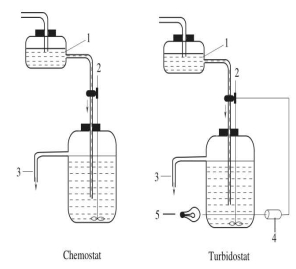









 DownLoad:
DownLoad:

